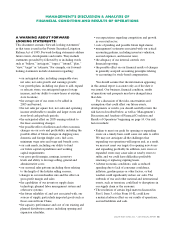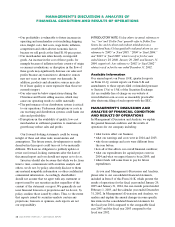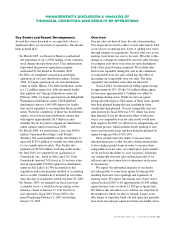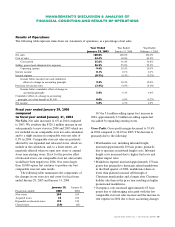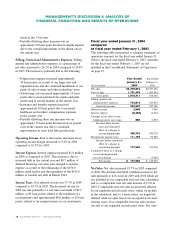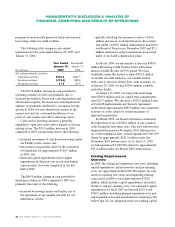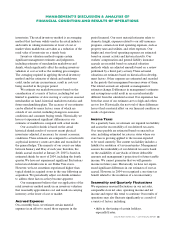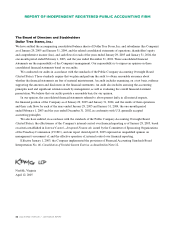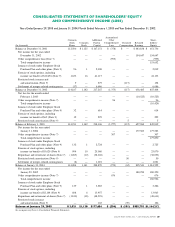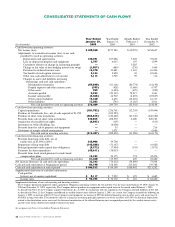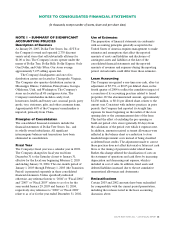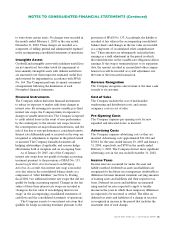Dollar Tree 2004 Annual Report Download - page 27
Download and view the complete annual report
Please find page 27 of the 2004 Dollar Tree annual report below. You can navigate through the pages in the report by either clicking on the pages listed below, or by using the keyword search tool below to find specific information within the annual report.
DOLLAR TREE STORES, INC. • 2004 ANNUAL REPORT 23
inventories. The retail inventory method is an averaging
method that has been widely used in the retail industry
and results in valuing inventories at lower of cost or
market when markdowns are taken as a reduction of the
retail value of inventories on a timely basis.
Inventory valuation methods require certain
significant management estimates and judgments,
including estimates of merchandise markdowns and
shrink, which significantly affect the ending inventory
valuation at cost as well as the resulting gross margins.
The averaging required in applying the retail inventory
method and the estimates of shrink and markdowns
could, under certain circumstances, result in costs not
being recorded in the proper period.
We estimate our markdown reserve based on the
consideration of a variety of factors, including but not
limited to quantities of slow moving or carryover seasonal
merchandise on hand, historical markdown statistics and
future merchandising plans. The accuracy of our estimates
can be affected by many factors, some of which are
outside of our control, including changes in economic
conditions and consumer buying trends. Historically, we
have not experienced significant differences in our
estimates of markdowns compared with actual results.
Our accrual for shrink is based on the actual
historical shrink results of our most recent physical
inventories adjusted, if necessary, for current economic
conditions. These estimates are compared to actual results
as physical inventory counts are taken and reconciled to
the general ledger. The majority of our counts are taken
between January and May of each year; therefore, the
shrink accrual recorded at January 29, 2005 is based on
estimated shrink for most of 2004, including the fourth
quarter. We have not experienced significant fluctuations
in historical shrink rates in our Dollar Tree stores.
However, we have sometimes experienced higher than
typical shrink in acquired stores in the year following an
acquisition. We periodically adjust our shrink estimates
to address these factors as they become apparent.
Our management believes that our application of the
retail inventory method results in an inventory valuation
that reasonably approximates cost and results in carrying
inventory at the lower of cost or market.
Accrued Expenses
On a monthly basis, we estimate certain material
expenses in an effort to record those expenses in the
period incurred. Our most material estimates relate to
domestic freight, expenses related to our self-insurance
programs, certain store level operating expenses, such as
property taxes and utilities, and other expenses. Our
freight and store-level operating expenses are estimated
based on current activity and historical results. Our
workers’compensation and general liability insurance
accruals are recorded based on actuarial valuation
methods which are adjusted annually based on a review
performed by a third-party actuary. These actuarial
valuations are estimates based on historical loss develop-
ment factors. Other expenses are estimated and recorded
in the periods that management becomes aware of them.
The related accruals are adjusted as management’s
estimates change. Differences in management’s estimates
and assumptions could result in an accrual materially
different from the calculated accrual. Our experience has
been that some of our estimates are too high and others
are too low. Historically, the net total of these differences
has not had a material effect on our financial condition or
results of operations.
Income Taxes
On a quarterly basis, we estimate our required tax liability
and assess the recoverability of our deferred tax assets.
Our taxes payable are estimated based on enacted tax
rates, including estimated tax rates in states where our
store base is growing applied to the income expected
to be taxed currently. The current tax liability includes a
liability for resolution of tax uncertainties. Management
assesses the realizability of our deferred tax assets based
on the availability of carrybacks of future deductible
amounts and management’s projections for future taxable
income. We cannot guarantee that we will generate
income in future years. Historically, we have not experi-
enced significant differences in our estimates of our tax
accrual. However, in 2004 we recognized a one time tax
benefit related to the resolution of a tax uncertainty.
Seasonality and Quarterly Fluctuations
We experience seasonal fluctuations in our net sales,
comparable store net sales, operating income and net
income and expect this trend to continue. Our results of
operations may also fluctuate significantly as a result of
a variety of factors, including:
• shifts in the timing of certain holidays,
especially Easter;
MANAGEMENT’S DISCUSSION & ANALYSIS OF
FINANCIAL CONDITION AND RESULTS OF OPERATIONS


